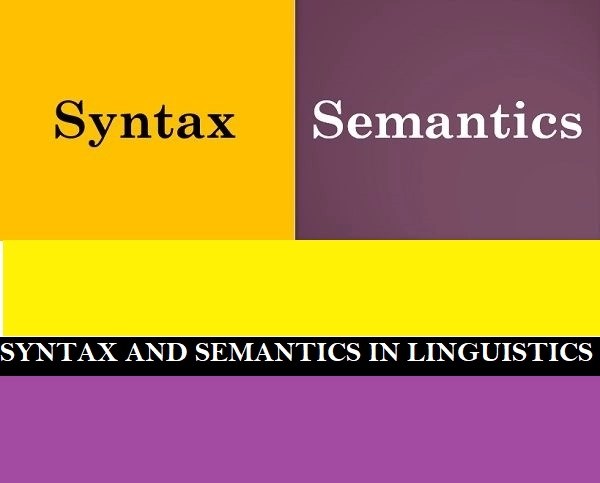
Syntax and semantics are two of the most critical aspects of linguistics. The Syntax is what defines how words are combined to form sentences, phrases and clauses. Semantics is the study of meaning from word meanings, sentence structure, context clues, or everything derived from language. This blog post will define these terms and provide some examples of Syntax and semantics in linguistics. We will also discuss practices for you to follow when working with Syntax and semantics in your language studies.
What is Syntax in Linguistics?
Syntax refers to the study of how words are combined and arranged in a language. The Syntax is generally considered an umbrella term encompassing morphology and phonology (the sound system) within linguistics.
- Morphology deals with the internal structure of words such as prefixes or suffixes;
- While phonology looks at the sounds made by languages, including intonation patterns.
Syntax also includes the study of phrases, clauses, sentences as well as intonation patterns within languages. Let’s take a look at some examples of Syntax that might be useful for your studies:
a. Clauses
In linguistics, we often categorize clauses based on their function. For example, there can be independent or dependent clauses that express different meanings despite being made up of the same subject and predicate (e.g., “I want ice cream” vs. “Because I want ice cream”). Clauses can also act under another clause such as an adverbial clause, relative clause, etc.
b. Phrases
Phrases are groups of related words without both a subject and predicate (e.g., “in the end”). Phrases can be categorized into different types, such as noun phrases, verb phrases or prepositional phrases, etc.
c. Sentences
A sentence is also known as an independent clause because it expresses a complete thought without another clause under it that controls its meaning.
Examples of Syntax in Linguistics:
Due to the fact that Syntax deals with word arrangement, there are often rules associated with certain types of sentences (declarative, interrogative, etc.). One example includes a subject-verb agreement where verbs must match their subjects. However, some languages require verb changes depending upon who you talk about, such as third-person singular -s like “he eats” instead of “they eat.” Another example can be seen within interrogative sentences such as “Did you go to the park?” where the question marker (did) must come at the beginning of a sentence.
The subject comes before the predicate (e.g., “I walked slowly,” not *Slowly I walked). The verb must agree with its subject (e.g., “We ate hamburgers.” Not “Hamburgers we ate.”)
The Negative adverb does not come before the verb (e.g., “We didn’t eat hamburgers.” Not * Ate we hamburgers not) Auxiliary or helping verbs such as have, would, and should must come in a specific order with main verbs (e.g., I would like to go vs. I go to want).
What are the Practices of Syntax in Linguistics?
To write a good sentence, you must follow proper Syntax. The Syntax is all about word arrangement, which can be tricky in English, where rules are not always followed. To ensure that your sentences follow proper Syntax, you should do the following:
- Be familiar with subject-verb agreement. Keep verbs consistent with their subjects (e.g., “The dog chases its tail.” Not “Chase its tail the dog.”)
- Know how to use auxiliary verbs correctly. Make sure auxiliaries come before main verb phrases( e.g., He has learned vs. he learned)
- Check for run-on sentences and comma splices. Avoid long strings of words or groups of clauses without periods between them (e.g., Bob went home, then he went to the store.)
- Avoid irregular verbs. Be aware of words that are often misspelled, such as “been” for “to have been.”
Practices for Syntax include following the rules discussed above and using correct tenses, cases, and agreement. Tense shows whether an action has been completed or not (e.g., “I walk to school” vs. “I walked to school.”) Cases show relationships between words such as subject-object (e.g., John likes Mary vs. Mary likes John). Agreement refers to singular-plural; however, some languages don’t require this, like Japanese, which has one form regardless of number.
What is Semantics in Linguistics?
Semantics refers to how language conveys meaning, from word meanings and context clues to cultural references. Some aspects include:
- Denotation: what words refer to;
- Connotation: how they are used based upon their associated emotions or thoughts;
- Pragmatics: the way that context can alter certain parts of speech;
- Morphology: how different forms of one word have specific uses depending on who they are being applied towards.
Other types of semantics include:
- Lexical semantics: similarities in vocabulary across languages, especially when it comes down to describing similar concepts;
- Social semantics: how language reflects the culture and society it is being used amongst; as well as
- Formal semantics, which focuses on specific aspects within a sentence.
Semantics refers to the study of how words acquire meaning within language structure. While Syntax looks at word order, morphology, and internal structures of words, semantics takes a closer look at what each word means based on context clues from sentences around them. In addition, semantic theory considers how social factors and cultural contexts affect the meaning, which relates very closely to pragmatics. Let’s take a look at some examples of semantics that might be useful for your studies:
a. Irony
This is a figure of speech used to convey the opposite meaning by saying something that means its exact opposite. For example, if someone is sarcastic, they might say, “I love ice cream!” when they mean “I don’t like it.”
b. Cultural References
Words and phrases within a language can be influenced by society or culture, such as slang words often associated with youth subcultures or different places worldwide. In addition, idioms demonstrate the integration between semantics and pragmatics. There may not always be a literal translation for certain expressions (e.g., raining cats and dogs – meaning pouring down rain).
c. Pragmatics
It deals with how context alters meanings in language through nonverbal cues, including tone of voice, eye contact, and body language. It is also known as contextual meaning, which can change the entire definition based on its being said. And where certain parts may not even be necessary for communication to take place (e.g., “I’m going out.” vs. “When are you coming home?”).
Examples of Semantics within Linguistics:
One example of semantics would understand the difference between connotation and denotation. While both words are associated with specific meanings, certain factors contribute to how they can alter their original meaning, such as adverbs (e.g., “She looked furious” vs.” She angrily shouted”). Connotations refer to emotional undertones or subjective ideas associated with words that vary from person to person. However, denotations tend to represent more objective facts about language use without cultural implications (E.g., chocolate chip cookies vs. dirty water dogs).
Another example is differentiating homonyms like read (past tense) and read (present tense), where context helps determine if someone has already completed something or it’s currently taking place based upon sentence structure.
What are the Practices of Semantics in Linguistics?
The practices involved with semantics within linguistics include:
- Denotation: how words are applied to different objects or ideas;
- Connotation: the emotional and cultural associations that come with certain words due to their use within society, and
- Pragmatics: how certain types of context alter the way words are used.
The main focus within semantics is lexical semantics across languages, sociolinguistics which focuses on language variation linked to social factors, and formal semantics, which looks at specific parts of sentences individually based upon their structure.
An effective practice within the study of semantics is how words acquire meaning and what information they can convey based upon their usage. Some research has shown that certain languages may vary – signifiers (what we refer to when using a word) and signifiers (what we mean by it). For example, apples refer to fruit, but in Spanish, manzanas refer to an apple brand.
Linguists also look at pragmatics which deals with context surrounding language use such as cultural references or social factors including:
1) Politeness level: how much respect you show towards others depending on your relationship (e.g., formal/informal);
2) Gender Differences: differences between genders when speaking about certain topics (e.g., sports vs. fashion); and
3) Personal Space: the physical distance people tend to maintain from one another when speaking or interacting with others.
Linguistics looks at words’ denotation, connotation, and pragmatics to study how they acquire meaning within a certain language structure and the social factors that influence their usage based on a society’s specific norms around them.
Conclusion
Syntax and semantics within linguistics are a vital part of how we communicate through language using its proper structure and understanding what associated meanings come with it based upon their usage. An example would include denotation vs. connotation, where both share similar definitions but convey exact information depending on context due to societal norms/values around them. However, these factors do not explain why semantics within linguistics are important overall when making communication effective through language use. The practices involved within syntactic and semantic research deal with how words get their meanings, the associated attitudes surrounding them, and what types of information they can convey based on context.




